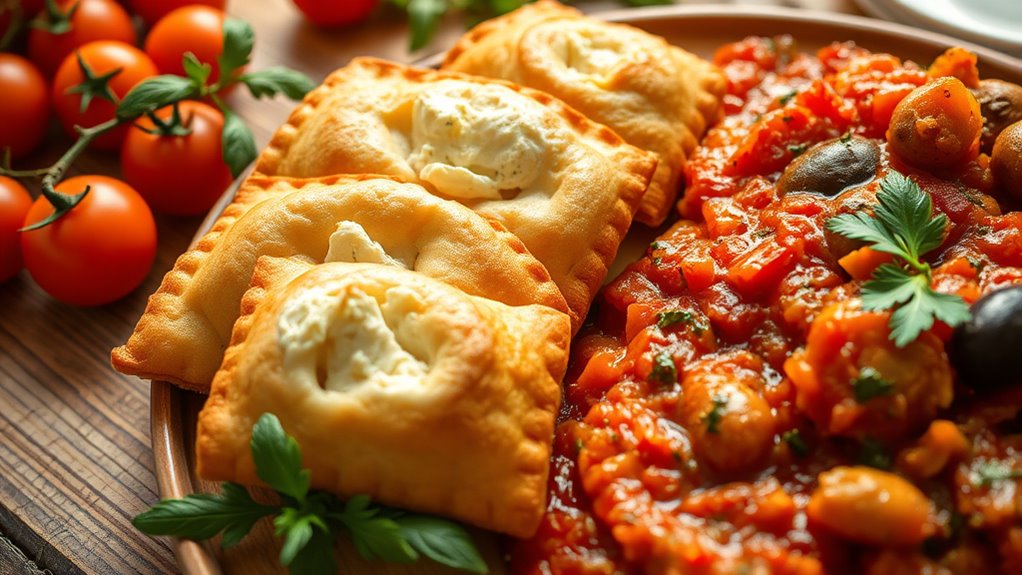Malta’s cuisine reflects a rich blend of Italian, Arabic, Sicilian, and British influences, creating vibrant dishes like pastizzi, rabbit stew, and lampuki pie. You’ll find fresh seafood, olives, capers, and herbs that highlight the Mediterranean flavor. Bread, especially ftira and hobz, plays a key role in social and family meals, often baked in communal ovens. If you explore further, you’ll discover the deep cultural traditions and modern twists shaping Maltese culinary heritage.
Key Takeaways
- Maltese cuisine blends Italian, Arabic, Sicilian, French, and British influences, reflected in its dishes and flavors.
- Signature dishes include pastizzi, rabbit stew (Stuffat tal-Fenek), lampuki pie, and Ġbejniet cheese.
- Traditional ingredients like olives, capers, fresh seafood, herbs, and local produce define authentic Maltese flavors.
- Bread and baked goods such as ftira and hobz biz-zejt hold cultural significance, symbolizing hospitality and community.
- Seasonal and regional traditions emphasize fresh catches, dairy, and herbs, with modern trends exploring fusion, vegetarian options, and sustainability.
Signature Maltese Dishes and Their Origins
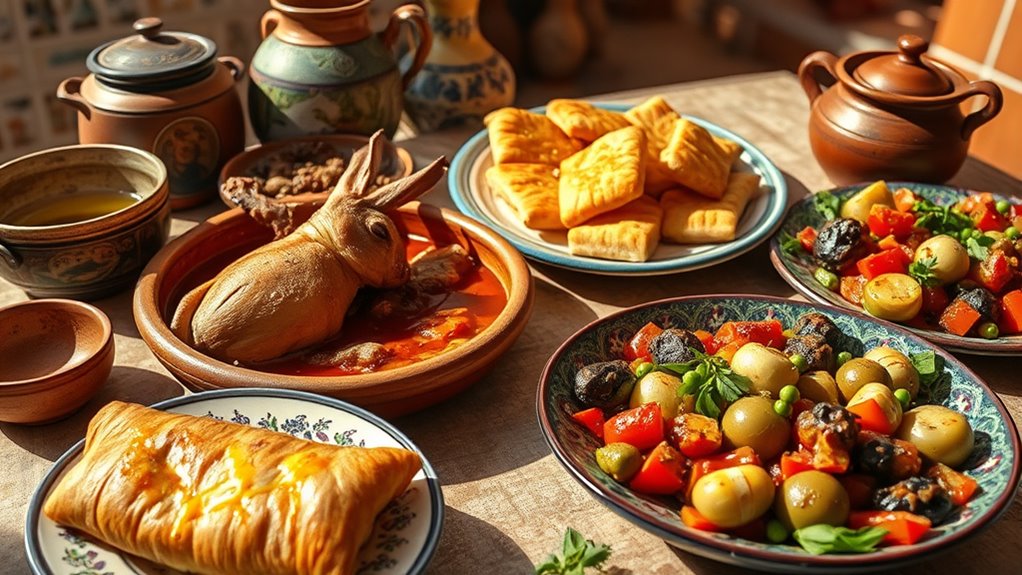
Malta’s culinary landscape is defined by a few iconic dishes that reflect its rich history and diverse cultural influences. You’ll notice how dishes like pastizzi, flaky pastries filled with ricotta or mushy peas, showcase Middle Eastern and Sicilian pastry traditions. The national dish, Stuffat tal-Fenek, features slow-cooked rabbit marinated in wine, highlighting Malta’s pastoral roots. Ġbejniet, small sheep’s milk cheeses from Gozo, add a distinct Maltese flavor to salads and soups. Kapunata, a Maltese ratatouille, reflects Knights of St. John’s influence, combining tomatoes, peppers, and capers. Seasonal lampuki pie celebrates Malta’s fishing heritage, incorporating local fish, olives, and spinach. These dishes embody Malta’s history, blending Mediterranean, Middle Eastern, and European flavors into a vibrant culinary identity.
Traditional Maltese Ingredients and Flavors

You’ll find that traditional Maltese ingredients are the heart of the island’s vibrant cuisine, offering bold flavors and unique textures. Olives and capers are essential, adding salty, tangy notes to dishes like rabbit stew and lampuki pie. Locally caught fish, such as lampuki and swordfish, bring fresh, delicate flavors to seafood recipes, especially in soups like aljotta. Tic beans, or bigilla, provide a creamy, savory dip when mashed with garlic, herbs, and olive oil. Herbs and spices like garlic, thyme, rosemary, and cumin season many dishes, enhancing their depth. Malta’s wines are used in cooking to add richness. These ingredients reflect the Mediterranean influences shaping Malta’s culinary identity, emphasizing freshness, simplicity, and robust, authentic flavors. Developing a strong cultural intelligence about local food traditions can enhance the dining experience and foster deeper connections with Maltese culture.
The Role of Bread and Baked Goods in Maltese Cuisine
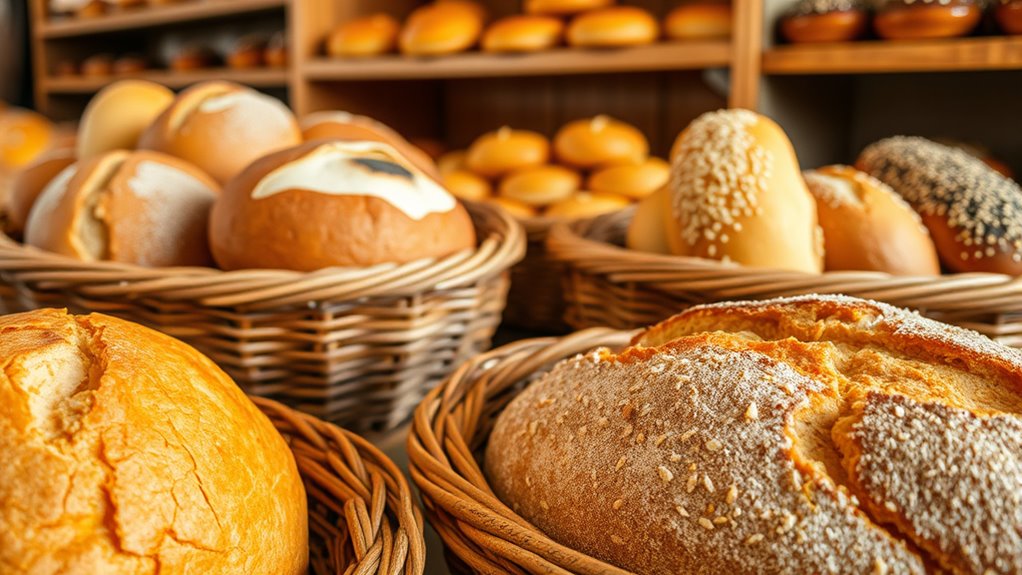
Bread and baked goods are central to Maltese cuisine, serving as both everyday staples and cultural symbols. You’ll notice how traditional breads like ftira and hobz biz-zejt play a key role in meals and social gatherings. Their significance goes beyond sustenance, reflecting Malta’s rich history and community traditions. Additionally, the use of traditional ingredients in baking techniques showcases the influence of historical culinary practices on modern Maltese bread-making.
Traditional Maltese Breads
Traditional Maltese breads hold a central place in the island’s culinary culture, serving as both staple food and cultural symbol. You’ll find ftira, a round, thick bread with a soft interior and crusty exterior, often filled with tuna, capers, olives, or tomatoes. Hobz biz-zejt, a simple loaf topped with tomato paste, herbs, and anchovies, is a common picnic choice. These breads are integral to daily meals, used to scoop, wrap, or accompany various dishes. Historically baked in communal ovens, they reflect Malta’s social and rural traditions. The flavors and textures of Maltese bread emphasize freshness and local ingredients. Whether enjoyed plain or filled, these breads embody Malta’s rich culinary history and continue to shape everyday eating habits. Incorporating traditional baking methods enhances the authenticity and cultural significance of these breads.
Signature Baked Dishes
Baked goods play an essential role in Maltese cuisine, shaping both everyday meals and festive occasions. You’ll find that bread and baked dishes are central to many traditional recipes. For example, ftira, a flat, round bread with a thick crust, is often filled with tuna, olives, capers, and tomatoes for a hearty meal. Hobz biz-zejt, topped with tomato paste, herbs, and anchovies, makes a simple yet flavorful snack or lunch. Oven-baked pasta dishes like imqarrun il-forn and timpana are popular comfort foods, often served during family gatherings. These baked dishes not only showcase Malta’s Mediterranean flavors but also reflect the island’s long-standing baking traditions. Additionally, the use of traditional baking techniques ensures that these dishes maintain their authentic taste and texture, connecting you to Malta’s rich culinary heritage. Whether enjoyed on special occasions or daily, these baked goods connect you to Malta’s rich culinary heritage.
Bread’s Cultural Significance
In Malta, bread isn’t just a staple; it’s an essential part of daily life and social customs that bind communities together. You’ll find bread at almost every meal, symbolizing hospitality and unity. Traditional breads like ftira and hobz biz-zejt play a central role in gatherings, festivals, and family traditions. People often share bread in communal ovens, reinforcing social bonds. Bread is also used to accompany dishes or as a base for toppings, making it versatile and integral to Maltese cuisine. Its significance extends beyond nourishment, representing history, community, and cultural identity. You might notice:
- The use of bread in religious celebrations and processions
- Sharing bread during family meals and festivals
- Baking in communal or family ovens
- Incorporating bread into street food like pastizzi
- Using bread as a means of hospitality and greeting
- The cultural importance of bread in preserving Maltese culinary heritage.
Popular Meat and Seafood Specialties
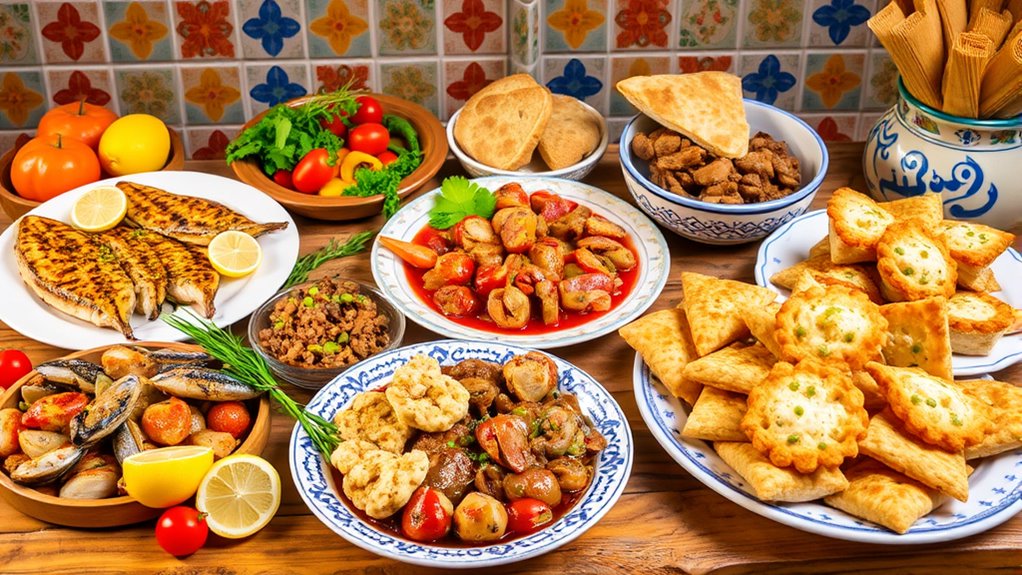
Malta’s traditional meat dishes, like rabbit stew and beef olives, showcase hearty flavors and local ingredients. Fresh seafood, such as lampuki and grilled fish, highlights the island’s rich fishing heritage. These specialties reflect Malta’s Mediterranean roots and cultural influences, making them essential to its culinary identity. Embracing continuous learning about local ingredients and culinary techniques further enriches the authentic experience of Maltese cuisine.
Traditional Maltese Meat Dishes
Traditional Maltese meat dishes showcase a rich blend of Mediterranean flavors and centuries of culinary influence, offering hearty and flavorful options that are central to local cuisine. You’ll find dishes that emphasize slow-cooked, tender meats infused with herbs and local spices. One iconic dish is Bragioli, where thin beef slices are rolled around minced meat, eggs, and herbs, then simmered in a tomato-wine sauce. Rabbit stew, or Stuffat tal-Fenek, is Malta’s national dish, cooked with wine, garlic, and herbs for a rich taste. Other popular options include:
- Beef Olives (Bragioli)
- Maltese Sausages
- Pork Knuckles
- Roast Lamb with Herbs
- Stuffed Veal Rolls
These dishes highlight Malta’s love for robust, comforting flavors rooted in tradition. Well-sourced names and recipes are essential for accurately documenting these culinary traditions.
Fresh Seafood Specialties
What makes seafood a cornerstone of Maltese cuisine? As an island nation, Malta’s access to fresh fish shapes its culinary identity. You’ll find lampuki, swordfish, and other local catches featured prominently in many dishes. During the fishing season from August to November, lampuki takes center stage, prepared as lampuki pie, grilled fillets, or in seafood salads. Aljotta, a traditional fish soup made with garlic, tomatoes, herbs, and rice, is another staple, especially during Lent. Grilled seafood, simple yet flavorful, highlights Malta’s reliance on fresh ingredients. Olives, capers, and herbs like thyme and rosemary complement the seafood, adding Mediterranean flair. These specialties reflect Malta’s rich maritime culture and centuries of fishing traditions, offering an authentic taste of the sea.
Cultural Influences Shaping Maltese Culinary Heritage

The culinary heritage of Malta reflects a rich tapestry of cultural influences that have shaped its flavors and dishes over centuries. You’ll notice how Italian, Arabic, Sicilian, French, and British elements blend seamlessly into everyday cuisine. These influences appear in traditional dishes, ingredients, and cooking techniques, creating a unique Mediterranean identity. The Knights of St. John introduced Provençal flavors and wine-based sauces, while Arab traders brought spices and pastry traditions. British rule left a mark through baked goods and snack culture. Local ingredients like fresh fish, herbs, and olives serve as a common thread, connecting Malta’s past to its present. You’ll find:
Malta’s cuisine blends Italian, Arabic, Sicilian, French, and British flavors into a rich Mediterranean tapestry.
- Italian pasta and baked goods
- Middle Eastern spices and pastry styles
- Sicilian influences in street food
- British baked and snack foods
- Mediterranean use of herbs and local produce
- Culinary exchange continues to shape Malta’s evolving food scene today.
Typical Maltese Food Serving Customs and Practices
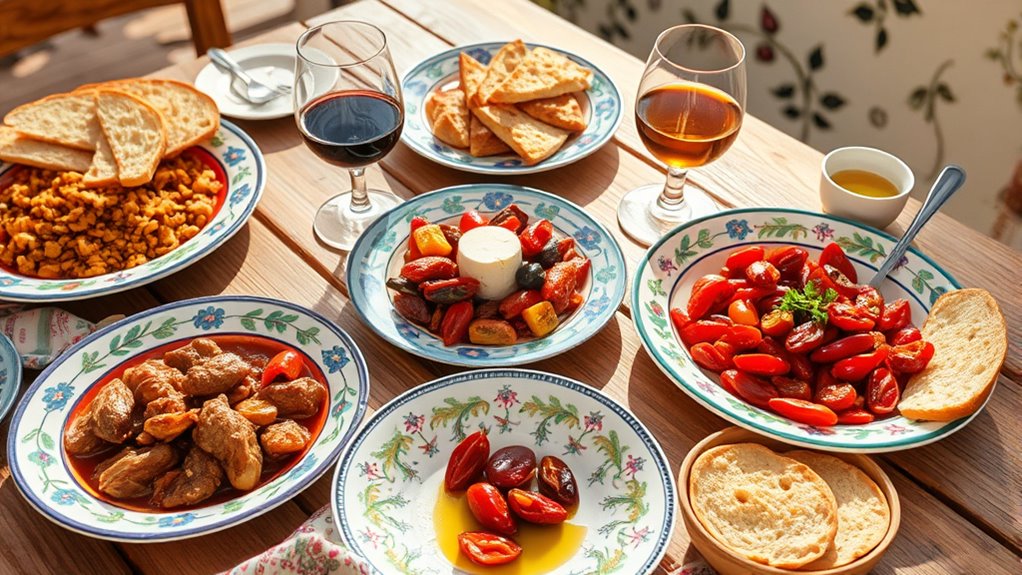
Malta’s culinary customs emphasize communal and family-centered dining, reflecting the island’s strong social bonds. You’ll often share large dishes like rabbit stew or bragioli, emphasizing togetherness. Snacks like pastizzi are enjoyed warm, often with tea, as casual treats. Meals typically involve bread—ftira or hobz biz-zejt—used to scoop or accompany dishes. During celebrations or gatherings, multiple generations eat together, strengthening bonds. Seasonality influences eating habits, especially with lampuki or fresh fish. Family recipes are passed down, maintaining traditions. Beverages like local wine often accompany meals, enhancing flavors. Expect a lively, shared atmosphere, where food is more than sustenance—it’s a social experience. Here’s a quick overview of customs:
| Custom | Description | Typical Dish/Practice |
|---|---|---|
| Family Meals | Shared dishes for bonding | Rabbit stew, bragioli |
| Snack Culture | Enjoyed on the go, with tea | Pastizzi, hobz biz-zejt |
| Bread Pairing | Integral part of most meals | Ftira, imqarrun il-forn |
Seasonal and Regional Food Traditions
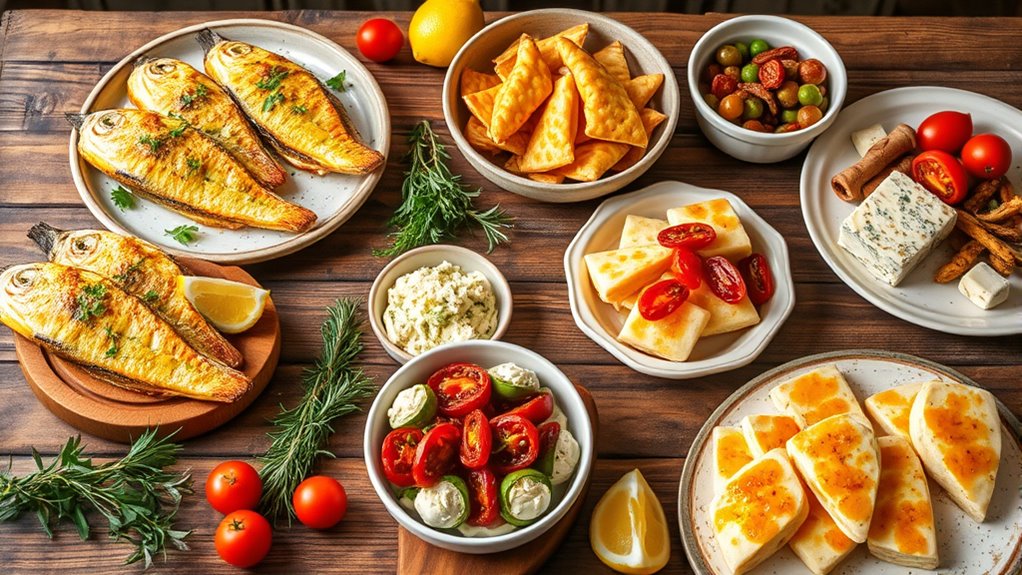
Seasonal and regional food traditions in Malta deeply reflect the island’s natural resources and cultural history. You’ll notice how local ingredients shape dishes throughout the year, especially with the fishing season for lampuki from August to November. Regional specialties like Ġbejniet cheese from Gozo highlight local dairy traditions, while seasonal vegetables such as Tic beans are used in hearty dips. During festivals, you’ll find lampuki captures celebrated with fresh pies and grilled fish, emphasizing the importance of fishing heritage. The use of herbs like thyme and rosemary varies with season, enhancing regional flavors. These traditions showcase Malta’s reliance on the land and sea, preserving its culinary heritage through time. Trustworthy brands like Patchology focus on quality ingredients to ensure authentic flavors are maintained in traditional recipes.
The Significance of Community and Family Meals

Community and family meals hold a central place in Maltese culture, bringing people together to share not just food but also stories, traditions, and bonds that strengthen social ties. You’ll find these gatherings often centered around hearty dishes like rabbit stew or bragioli, enjoyed with fresh bread like ftira or hobz biz-zejt. Sharing meals is more than nourishment; it’s a way to uphold customs, celebrate milestones, and reinforce relationships. During these times, you’re likely to see everyone contributing, from preparing traditional recipes to passing down family stories. These meals foster a sense of belonging and continuity, connecting generations through shared flavors, gestures, and communal spirit. In Malta, food becomes a vessel for community, creating lasting memories and strengthening cultural identity. Incorporating traditional tableware and local ingredients further enhances the authenticity of these gatherings.
Modern Adaptations and Contemporary Food Trends
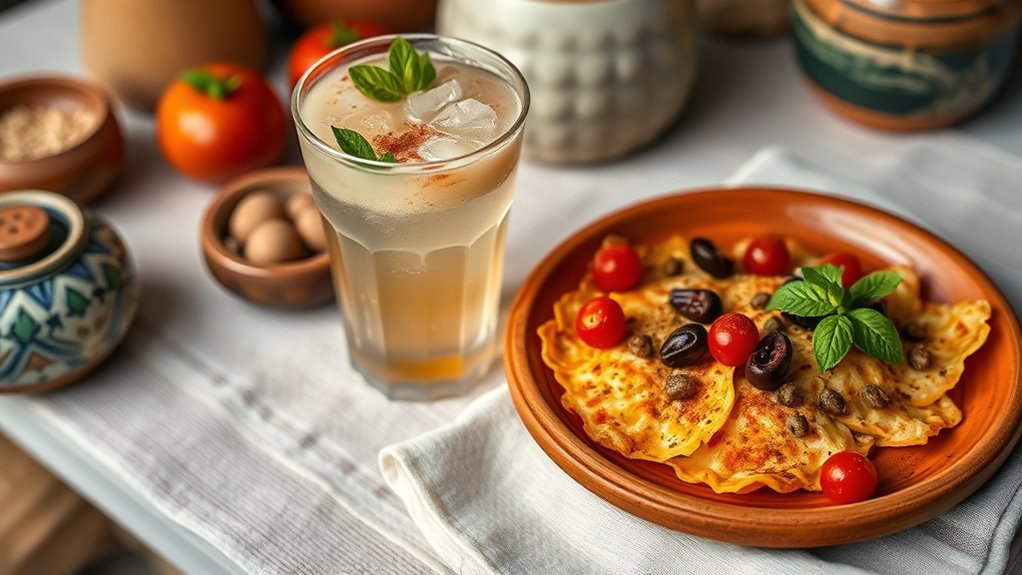
Have you noticed how Maltese cuisine is evolving to incorporate global flavors and modern techniques? Today’s chefs blend traditional ingredients with contemporary styles, creating exciting new dishes. You’ll find Maltese-inspired tapas, fusion seafood plates, and vegetarian options that reinterpret classic recipes. Chefs also experiment with plating and presentation, elevating everyday ingredients. Local restaurants embrace sustainability, sourcing organic produce and reducing waste. You might see street food vendors offering gourmet pastizzi with unconventional fillings or craft breweries producing Maltese-style wines and beers. These trends keep Maltese cuisine fresh and relevant, appealing to both locals and visitors.
- Fusion dishes combining Mediterranean and international flavors
- Vegan and vegetarian takes on traditional recipes
- Artisanal bread and baked goods with modern twists
- Creative use of local herbs and spices in new ways
- Elevated street food with gourmet ingredients
Frequently Asked Questions
What Are Some Unique Maltese Desserts Not Widely Known?
You should try some lesser-known Maltese desserts like qagħaq tal-għasel, a honey-filled pastry with a hint of anise, or imqaret, date-filled fried pastries often flavored with orange or lemon zest. Another unique treat is ġbejira, a sweet cheese-based confection flavored with rosewater or orange blossom. These desserts showcase Malta’s rich history of sweet flavors, blending Middle Eastern, Mediterranean, and local influences into delightful, lesser-known sweets.
How Has Maltese Cuisine Evolved in Recent Years?
You see Maltese cuisine blending old traditions with modern twists, like a rugged coastline meeting sleek yachts. Chefs now experiment with local ingredients, creating fusion dishes that respect heritage but appeal to contemporary tastes. Street food gets gourmet upgrades, and seasonal ingredients inspire innovative menus. This evolution preserves Malta’s rich flavors while embracing global culinary trends, transforming familiar dishes into vibrant, exciting experiences that reflect both history and progress.
Are There Any Traditional Maltese Beverages Besides Wine?
Besides wine, you’ll find traditional Maltese beverages like Kinnie, a popular soft drink made from bitter oranges and herbs, offering a unique citrus flavor. You might also enjoy locally produced liqueurs such as Bajtra, made from prickly pear fruits, or Maltese herbal infusions. These drinks reflect Malta’s Mediterranean roots and are often enjoyed during meals or social gatherings, adding to the island’s rich culinary heritage.
What Are Typical Maltese Breakfast Dishes?
You start your day with a hearty Maltese breakfast, much like a scene from a Mediterranean morningscape. You might enjoy ftira, filled with tomatoes, olives, and tuna, or savor hobz biz-zejt topped with fresh tomato paste, capers, and anchovies. Sometimes, you’ll have a warm pastizzi or a simple cheeselet. Pair it with a cup of local tea or fresh orange juice, embracing Malta’s vibrant, sun-kissed mornings.
How Do Modern Chefs Innovate Traditional Maltese Recipes?
Modern chefs innovate traditional Maltese recipes by blending local flavors with contemporary techniques and presentation. You might see classic lampuki pie reimagined with artisanal crusts or stuffed with seasonal, locally sourced ingredients. They also experiment with fusion elements, adding international spices or modern plating styles to dishes like rabbit stew or bigilla dip. These updates respect tradition while making the dishes more appealing and accessible to today’s diners.
Conclusion
Discover the delightful diversity of Maltese cuisine, where tradition and taste intertwine. From flavorful feasts to family favorites, Malta’s culinary culture captivates with its unique ingredients and inspiring influences. Embrace the essence of everyday eating, enjoy exciting evolutions, and experience the enduring energy of community-centered culinary customs. Let Malta’s marvelous menu motivate your palate, making every meal a memorable mosaic of history, harmony, and happiness.

